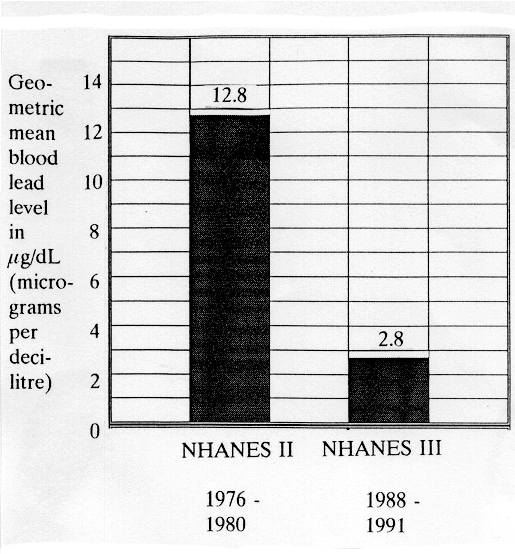|
|
||||
|
LEAD Action News
Vol
2 no 4
Spring 1994.
ISSN 1324-6011 |
||||
|
About Us
|
The Decline in Blood Lead
Levels in the United States by James L. Pirkle, MD, PhD; Debra J. Brody, MPH; Elaine W. Gunter; Rachel A. Kramer, ScD; Daniel C. Paschal, PhD; Katherine M. Flegal, PhD, MPH; Thomas D. Matte, MD, MPH The following abstract is reprinted from the Journal of the American Medical Association (JAMA), July 27, 1994 - Vol. 272, No. 4, p. 284. http://jama.jamanetwork.com/article.aspx?articleid=376894 Objective. - To describe trends in blood lead levels for the US population and selected population subgroups during the time period between 1976 and 1991. Design. - Two nationally representative cross- sectional surveys and one cross-sectional survey representing Mexican Americans in the south-western United States. Setting/Participants. - Participants in two national surveys that included blood lead measurements: the second National Health and Nutrition Examination Survey (NHANES II), 1976 to 1980 (n=9832), and phase 1 of the third National Health and Nutrition Examination Survey (NHANES III), 1988 to 1991 (n=12 119). Also, Mexican Americans participating in the Hispanic Health and Nutrition Examination Survey (HHANES), 1982 to 1984 (n=5682). Results. - The mean blood lead level of persons aged 1 to 74 years dropped 78%, from 0.62 to 0.14 µmol/L 12.8 to 2.8 µg/dL). Mean blood lead levels of children aged 1 to 5 years declined 77% (0.66 to 0.15 µmol/L [13.7 to 3.2 µg/dL]) for non- Hispanic white children and 72% (0.97 to 0.27 µmol/L [20.2 to 5.6 µg/dL]) for non-Hispanic black children. The prevalence of blood lead levels 0.48 µmol/L (10 µg/dL) or greater for children aged 1 to 5 years declined from 85.0% to 5.5% for non-Hispanic white children and from 97.7% to 20.6% for non-Hispanic black children. Similar declines were found in population subgroups defined by age, sex, race/ethnicity, income level, and urban status. Mexican Americans also showed similar declines in blood lead levels of a slightly smaller magnitude over a shorter time. Conclusions. - The results demonstrate a substantial decline in blood lead levels of the entire US population and within selected subgroups of the population. The major cause of the observed decline in blood lead levels is most likely the removal of 99.8% of lead from gasoline and the removal of lead from soldered cans. Although these data indicate major progress in reducing lead exposure, they also show that the same socio-demographic factors continue to be associated with higher blood lead levels, including younger age, male sex, non-Hispanic black race/ethnicity, and low income level. Future efforts to remove other lead sources (eg, paint, dust, and soil) are needed but will be more difficult than removing lead from gasoline and soldered cans.
"The major cause of the observed decline in blood lead levels is most likely the removal of 99.8% of lead from gasoline and the removal of lead from soldered cans." |
|||
|
About
Us |
bell
system lead poisoning |
Contact Us
| Council
LEAD Project | egroups | Library
- Fact Sheets | Home
Page | Media Releases Newsletters | Q & A | Referral lists | Reports | Site Map | Slide Shows - Films | Subscription | Useful Links | Search this Site |
||||
|
Last
Updated 14 November 2012
|
||||

